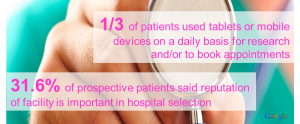Public relations has always played a valuable role in the marketing mix, especially for healthcare organizations. Reputation and patient referrals have traditionally been primary marketing tools for driving appointments and procedures. Now that digital marketing is becoming more prominent, many brands and businesses are shifting their focus to digital PR.
With the advent of digital marketing, PR remains the face and voice of a company, shining the spotlight on new product announcements, and diffusing the damage when a negative story, earnings report, or company scandal breaks to the press.
But today’s digital PR is much more. It’s become the virtual gatekeeper of company goodwill. Digital media is boosting public relations to new importance – turning yesterday’s “nice to have” to today’s essential for reputation management.
Rule #1: Never log off. Digital presence is too important.
The digital world moves faster than ever, with a virtually-instant power to spread stories — good and bad — with lightning speed. That means medical marketers must be vigilant about staying on top of an organization’s digital presence.
Keep a close watch on terms important to your organization. And remember, the most important goals for every public relations campaign are to:
- Control the conversation
- Control the flow of information
- Get the most possible promotion to the right people
- Increase your brand recognition
- Gain new patients, customers or fans
Lots of factors come into play to create a public impression: a company’s advertising, website, blog, social media, content they create and share with their audience. These all come into play on the Internet.
Rule #2: You must move as fast as your patients.
The healthcare system is at a tipping point. New regulations and economic pressures have created a mandate for change. At the same time, new technologies, data, diagnostics and delivery models are making large-scale improvement virtually inevitable.
With the change comes tremendous opportunity – to be at the forefront of progress and to engage more deeply with clinicians, patients, commercial partners and advocacy groups. And it’s all happening now. Progressive healthcare organizations must serve patients in the ways they prefer – including mobile websites and access – to remain the preferred providers.
Rule #3: Every negative review needs immediate attention.
It’s not always fair. But the harsh reality of today’s digital is that everyone with a complaint can find a place to air their grievances.
Even if you and your staff do everything right, every day, there’s no way to prevent the occasional disgruntled patient from stepping on the digital soapbox and sharing his/her frustration.
Simply accept that negative ratings and reviews are inevitable, and that they must be addressed quickly. How quickly? Consider how widespread the use of social media has become.
45.6% of US adults searched for health information when using social media
33.8% asked for health advice on social media
27.1% asked for doctor or hospital recommendations using social media
20.6% rated the quality of care they received from a healthcare provider using social media
If you do see a negative review of your organization online, make time to reach out to the individual with an offer to make it up to him or her, or simply to investigate. The sheer demonstration of your interest will help soften the impact of the negative statements – and you may be able to retain a patient!
Rule #4: Conversations count more than monologues.
Digital PR differs from traditional PR in a single, but very significant way. It’s the practice of managing communication between an organization and its publics.
- PR= “earned media”
- PR results in third party credibility
The traditional definition of PR is the practice of managing communication between an organization and its publics. In fact, in late 2011, the Public Relations Society of America (PRSA) launched Public Relations Defined, a (long overdue) initiative to develop
“a modern definition for the new era of public relations.”
The revised definition states: “Public relations is a strategic communication process that builds mutually beneficial relationships between organizations and their publics.”
The industry has truly transitioned from straightforward communication to multi way conversation.
Keep this new model in mind by listening, as well as talking, through your public relations efforts. Ask for feedback. Offer ways readers can learn more. Anything you can do to facilitate the dialogue will be appreciated.
Want to learn more?
If you liked what you read, and would like to learn more about Content Marketing or Social Media Marketing, join AIS Media’s summer webinar series, “The New Rules of Digital Marketing for Medical & Healthcare Organizations”.



